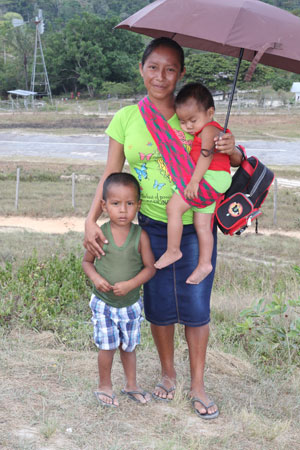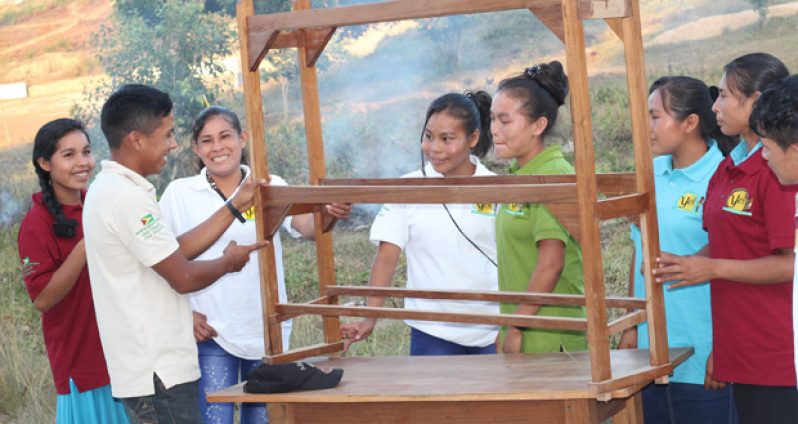– Skills-training project helping
By Faizool Deo
ELVERA Mark clutches her sleeping one-year-old child, who is harnessed in a sling; she also holds his older brother and an umbrella in her hands while carrying a backpack.

She hurries down the pathway from the clinic near the airstrip in Paramakatoi. Reaching early afternoon classes means that she must finish all her chores, all the cooking and find someone to look after her children. But this period in her life is the best in years.
“I feel I have a chance to turn my life around, things were not going well before this,” Elvera said while working a sewing machine at the Paramakatoi Multipurpose Hall later that day.
After four years of no income, she is now learning an all-important skill.
The 25-year-old, is one of 26 persons granted a second chance in a new programme, the Hinterland Employment Youth Service (HEYS) project, which was launched in the Region 8 village early last month by Minister within the Ministry of Indigenous People’s Affairs Valerie Garrido Lowe.
The project, which will target approximately 20 young people (ages 16-35) in each indigenous village, was introduced in Paramakatoi with some persons coming from nearby areas: Mountain Foot and Bamboo Creek. Other villages will get their opportunities in the coming months.
There are several programmes that the villages can choose, but each will be required to do Mathematics and English (in the hope of some participants furthering their studies). The one-year project aims to give the recipients much-needed skills. Each month the students will also receive a stipend of $30,000; $20,000 however will be paid, while $10,000 will go towards a savings account which will then be given to them at the end of the programme.

The one-year programme has two phases: six months of classroom and skills-training and the other six months, practicals, which will see students being attached to various entities in their villages and possibly even the regional office. Young entrepreneurs will also get a chance to pitch their business start-up ideas.
It’s possible for the participants to get a grant from the government to establish a business after they will have completed the programme.
Minister Lowe, who re-visited the area recently, pointed out that the main objective of the programme is to give those participants a second chance. She told persons taking part in the course: “This programme is geared to empower each and every one of you. As minister I’m very passionate about young people becoming self-sufficient, and I’m also very passionate about people getting second chances.”
She explained that keeping $10, 000 from their stipend every month was to promote their ability to save money (a key component of their entrepreneurship studies class).
The minister was extremely impressed with the direction of the programme and the improvement of the participants.
She was elated that the girls were not just able to stitch, but that they were already sewing clothes.
Seasoned sewing teacher Shiv Mangal has led the group well; he pointed out that he is teaching garment construction.
“They are learning to sew shirts, pants, uniforms, dresses and mosquito nets.”
Along with sewing and the compulsory Mathematics and English classes, students in Paramakatoi are also being taught joinery, tourism and hospitality, entrepreneurship studies and lifeskills.
Both Minister Lowe and Minister of Indigenous People’s Affairs Sydney Allicock have been pushing community- based tourism in the villages as they aim to make the hinterland self-sufficient.
For Elvera and the other participants at Paramakatoi, the programme is more than a second chance. It’s a programme of hope. Most of the students did badly at the CSEC level and were left without an option. Some did not have the opportunity to write the exams.
Seventeen year-old Velma Sandwell explained it best: “I want to be someone better, I want to become someone and I feel that this programme can help me.”




.png)









